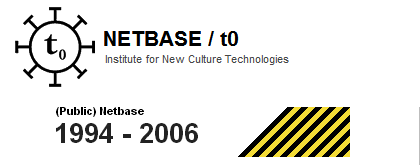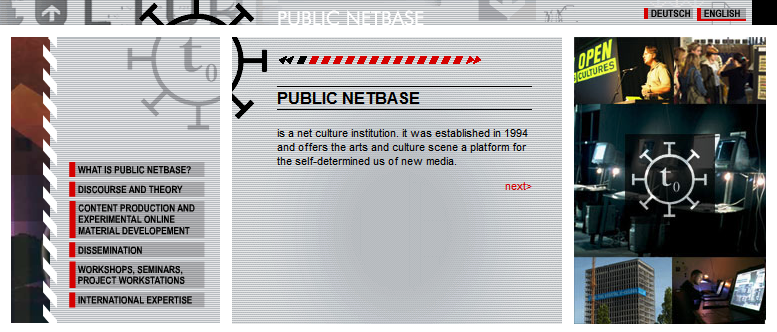Book review: Public Netbase: Non Stop Future/ New practices in Art and Media
“New information technologies have become ubiquitous and thoroughly established in our everyday life. This marks the end of a period of intense experimentations and speculations related to the introduction of global communication systems more than a decade ago. Artists and cultural workers were the first to explore the liberatory dimensions and to apply emancipatory potentials. These early pioneers developed a range of interdisciplinary models and practices in order to expand the scope of social participation in information society cultures. Initiatives like the radical Viennese media culture institution Public Netbase became important nodes in a global network dedicated to critical art, culture and science based on new media practices”.
A few words to begin with…
Those first few phrases consist part of the “Public Netbase: Non Stop Future/ New Practices in art and Media” editorial. Basically, this is the reader’s introduction to this complex compilation of articles, lectures, readings that underline Public Netbase’s perspective regarding new media practices’ effect on contemporary society and culture. To begin with, to comprehend the content of this poly-dimensional reader one should be familiar with the cultural media initiative of Public Netbase.
So, what about the project of Public Netbase?
Public Netbase was a net culture institution, first established in 1994 in Vienna, Austria. Also known as the t0 ( to zero, from the network’s domain name), Public Netbase was an institution that played the role of an open access net platform, supporting the development of electronical art and digital culture. From 1994 to 2006, Public netbase contributed in numerous art projects and interventions (for example, the Transformation Story Archive project). The awarded project of Public Netbase ended in 2006 when the state funding was cut off (despite its recognition from UNESCO) due to political controversy issues with the local conservative government.
Public Netbase was an initiative that acted in quite many fields: apart from the artistic side, its members were actively involved in fields such as politics, society, media. The subculture that emerged from their actions in Vienna could be easily connected to punk subculture as the DIY, non “sale out”, non conformity characteristics of the punk ideology were “priciples” that underlined Public Netbase’s project.
Public Netbase: A video- chronicle of 1994-2006
The reader
Although the grand days of Public Netbase belong to the (recent) past, its legacy has been treasured and communicated to the wide public in written form through this particular book. In 400 pages the (tens of) contributors of this edition have managed to collect and provide us with material proof of Public Netbase’s discourse on controversial contemporary issues. This reader is an opinion mosaic, whose individual digits are the views of many theoreticians, artists, media activists speculating on current “hot” new media issues or projects.
Through this kaleidoscopic combination of essays six aggregated categories have emerged (Discourse, New Art Practices, Digital Mediaculture, Networking and Participation, Public Netbase, World-Information.org), structuring the chapters/ themes of “Public Netbase: Non Stop Future/ New practices in Art and Media”.
Content
Each category/ chapter is devoted to a special theme, starting with the first chapter under the title of Discourse: a gathering of mainly lectures and speeches on subjects such as the future of the anti globalization movement, free software- hardware-culture even a guide of Frequently Asked Questions about the Public Domain in the age of web 2.0. Next on the row is a collection of readings dedicated to the New Art Practices field. From the very beginning, the introduction of this chapter the reader receives information on artwork that “incorporates an element of new media technology” and on art based project that Public Netbase was engaged with, such as the Text FM open broadcasting system, the piece of software that was developed in Vienna by Graham Harwood and Matt Fuller. The third theme of the book consists on essays that explore the notion of the relatively new concept of Tactical Media: of course, the introductory session could not have been structured more wisely way as it includes a comprehensive text of Felix Stalder on the 30 years of Tactical Media. For sure, this chapter could not feel as complete without the bits of Public Netbase’s past, as transferred to us through the series of New Kunstektion documents which give as a account of practical use of tactical media as seen from the reversed side, from the official authorities point of view. “Digital Mediaculture networking and participation” chapter includes essays reflecting on digital networks, the role of culture and participation in the networking era.
The last two thematic entities of this reader are devoted to an internal, introvert peek on Public Netbase’s texts ( e.g. “Let it RIP! Obituary of an Endless Myth: Public Netbase, 1994- 2006 by Brian Holmes) and on the world-information.org “environment for cultural production” and “independent platform of critical media intelligence”.
An overview
The most important element of “Non Stop Future/ New practices in Art and Media” is the feelings, the first impressions that can occur to an unsuspicious reader. Its vital element consists of the fact that the vast amount of information provided flow naturally. Simultaneously, a lively, vibrate procedure of learning takes place. On the same route, if one should characterize the word in just one phrase then the book’s only description would be “mind challenging”. Through the storming presentation of different notions and concepts, the quick alteration of the subject and the style of writing, the interconnection of the texts and the themes maintain the reader alert, intrigued. The interesting work that occurred throughout Public Netbase presence in the sector of new media -as it is presented in those pages- forms a bizarre interactive procedure between the book and the reader. In other words, each text is the source of questions and speculation from the reader’s view; each text is also the source of answers.
P.S:
Throughout this book’s presentation, my readers might have noticed links that lead straight to the texts for which the reference is made. This is due to the fact that the book is available online. However, I would like to grab the chance and refer to bits of recently acquired knowledge: “free distribution” is a significant idiom of our era but –same as free software, free hardware- free stands for content, for the liberating choise that one can make to support the content and has nothing to do with an economic offer ( as Eben Moglen repeats often in his discourse on Free Software, Free Culture: After the dotCommunist Manifesto, it is free as freedom of speech, not free as free beer). Therefore, and let them be the last words of this review, support the independent innovations of subculture, support the alternative choice, support the spiritual effort of its contributors. It’s definately worth it.
Vital Information:
Public Netbase: Non Stop Future
New Practices in Art and Media
Published 2008
Publisher: Revolver – Archiv für aktuelle Kunst
ISBN: 978-3-86588-455-8
Editors:
Branka Curcic, Zoran Pantelic / New Media Center_kuda.org
Editorial team:
Konrad Becker, Branka Curcic, Zoran Pantelic, Felix Stalder, Martin Wassermair
Editorial assistance:
Clemens Apprich, Katharina Ludwig, Wolfgang Sützl
Translation:
Design and layout: NinjaBoy Creations and kuda.org
Printed in: Daniel Print, Novi Sad
In cooperation with World-Information Institute / t0
*(Any part of this book may be reproduced in any form without the prior written permission of the publishers for educational and non-commercial use. The contributors and publishers, however, would like to be informed.)
Revolver – Archiv für aktuelle Kunst
Frankfurt am Main, Germany
mail: info@revolver-books.de
url: http://www.revolver-books.de
World-Information Institute / t0
Lehargasse 11/8 A-1060
Vienna, Austria
office@t0.or.at
url: http://world-information.org/wii
New Media Center_kuda.org
Brace Mogin 2, 21113 Novi Sad, Serbia
mail: office@kuda.org
url: http://kuda.org
List of Contributors

